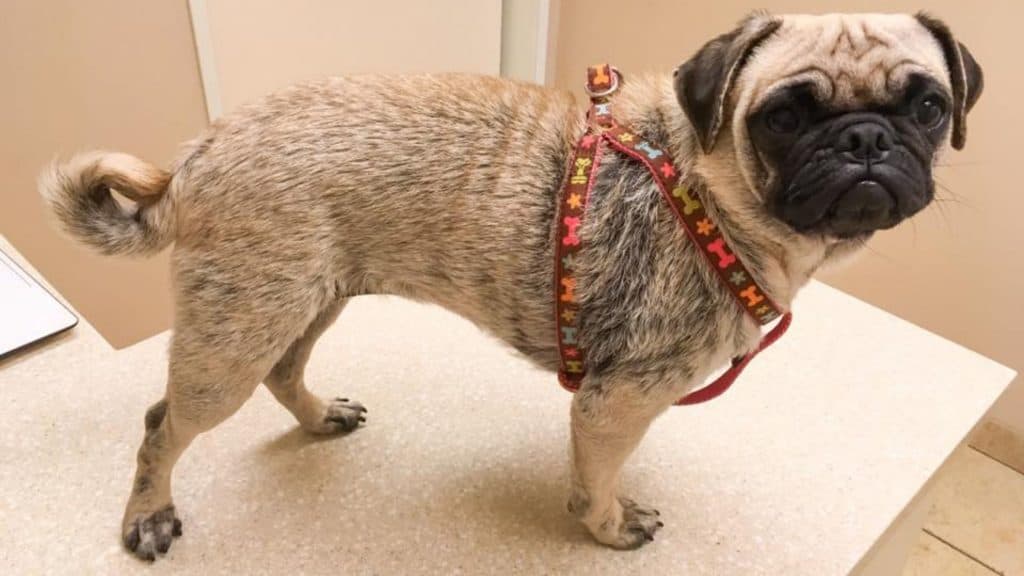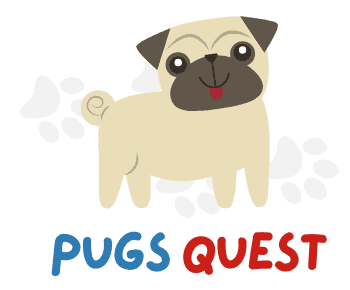
Dog shedding is perfectly natural. Pugs shed hair. More than you might think. But sometimes Pug hair loss goes beyond shedding, and that’s when it’s time to take action.
When Pug hair loss leads to bald spots it can be extremely concerning.
Today we’re going to discuss this topic in detail so that you’ll know what to look out for, what might be causing your Pug’s hair loss, and how you can help them get better.
Why is My Pug Losing Hair? When Should I Worry?
Before we dive into the disease causing Pugs to lose hair. Most healthy Pugs are losing hair because of shedding.
If you are a Pug owner, you know how heavy they are shedding. In fact, all dogs (including those advertised as hypoallergenic or non-shedding) shed.
If your Pugs are healthy but only shedding, you don’t need to worry. But sometimes hair-loss goes beyond just shedding.
As Pug owners, it’s so important to differentiate between normal shedding and a hair-loss that signals a potential health problem.
Hair loss can occur at any age, anywhere on the body but there are a few key indicators that you should look out for.
These include:
- Overall thinning of the hair
- Random patches of total hair loss
- Symmetrical patches of hair loss on either side of the body
- Hair loss around the eyes and mouth
- Skin irritation (red or inflamed skin, typically around the patches of hair loss)
- Dry or scaly skin around patches of hair loss
- Discharge, oozing, or bleeding around patches of hair loss
Note: this may indicate a secondary health condition so visit your vet asap.
What is Causing Pugs to Lose Hair in Massive Amounts?
There is a wide range of medical conditions that can cause massive hair loss in Pugs. If you notice any of the above signs and symptoms then you’ll want to consult your vet.
Typically, massive hair loss of Pugs is caused by one of the following conditions.
1. Parasites
If your Pug has parasites such as fleas, ticks, or mites then hair loss is a common symptom.
Mange, caused by the Demodex mite, is common amongst our canine friends and often results in hair loss and lesions around the eyes, legs, and trunk.
Ringworm is another common culprit. Signs of ringworm include bald patches in circular formations.
This can appear in various places around the body including a Pug’s head, limbs, ears, paws, and is sometimes accompanied by a red spot in the middle of the balding area.
2. Thyroid imbalance
Thyroid issues are another contributing factor when it comes to Pug hair loss. When Thyroid levels are out of whack, whether low (hypothyroidism), or high (hyperthyroidism), a Pug’s fur may begin to thin and become more brittle.
As well as hair loss, other indicators of thyroid problems include:
- Weight loss
- Scaly skin
- Breathing difficulties/ rapid breathing
- Changes in appetite or thirst
- Increased urination
- Heart murmur
- Increased appetite (with accompanying weight loss)
- Vomiting and/or diarrhea
If you suspect that your Pug might be suffering from a Thyroid imbalance you must visit your veterinarian as soon as possible. Thyroid imbalance often requires long-term treatment with hormone replacement medications.
3. Stress & anxiety
Hair loss can occur as the result of excess stress and anxiety. Pugs are prone to developing separation anxiety, especially in new environments. Unfortunately, this can actually lead to a condition called Telogen Effluvium, in which excess stress in your Pug’s body interferes with normal hair development.
Symptoms include:
- Thinning coat
- Hair loss (typically in large clumps)
- Excessive shedding and/or excessive hair-loss whilst grooming
- Bald spots
Thankfully, stress-induced hair loss will usually grow back without any intervention once your Pug’s anxiety has been dealt with sufficiently.
4. Allergies
If your Pug is experiencing an allergy of some kind (whether that be seasonal, environmental, or a particular food allergy) it can often affect their skin and coat. Allergies can make a dog’s fur more brittle and cause it to fall out.
Signs that your Pug might be having an allergy response include itchiness, scratching, rubbing, and/or biting to the point of fur loss.
Your vet will identify what your Pug is allergic to so that you can treat the symptoms and avoid the allergen in the future.
5. Diabetes
A dull and/or thinning coat could be a sign of diabetes. Canine diabetes can develop in both adolescent and adult dogs. Accompanying symptoms often include weight change, weakness, and increased thirst.
6. Cushing’s disease
Cushing’s disease (otherwise known as hyperadrenocorticism) occurs when a dog’s adrenal glands produce too much of the hormone cortisol. Cushing’s disease requires immediate treatment as, left untreated, the disease can reduce a dog’s lifespan.
As well as prolonged and progressive hair loss, Cushing’s disease often presents the following accompanying symptoms:
- Bruising
- Increased third
- Increased urination
- Weakness
7. Infection
Folliculitis occurs when the hair follicles become infected. This is an uncomfortable condition and can cause very sore blistering, crusting, and discharge on a dog’s skin.
Hair will typically become thinner in these areas, resulting in bald patches. Folliculitis can usually be treated with a course of antibiotics as prescribed by your vet.
Pyoderma is another common skin infection affecting Pugs. Pyoderma infections happen as the result of bacteria, parasites, allergies, or thyroid imbalances. Sometimes the infection can be exacerbated or brought on by poor grooming habits.
Symptoms include swelling, itching, blistering, scabbing, scaling, and redness to the skin accompanied by gradual hair loss.
8. Alopecia
Alopecia is the medical term used to describe hair loss that results from an unknown cause. Just like humans, Pugs too can develop alopecia.
This is a type of genetic baldness that typically manifests more as a dog ages. Unlike some other conditions, hair-loss that occurs because of alopecia will not grow back.
Can Pug Hair Loss be Reversed?
In most cases, Pug hair loss can be reversed and will grow back once the underlying condition is under control.
However, there are some conditions (such as canine Alopecia) that result in permanent hair loss to the affected site.
If your Pug has experienced a period of hair loss then it’s a good idea to offer them some extra protection from irritants and abrasive surfaces as they recover.
This will help promote hair growth and protect those balding and sensitive areas from further irritation.
Home Remedies: How Do I Get My Pug’s Hair Loss Under Control?
As soon as you notice abnormal hair loss, it’s important to first consult your veterinarian. They will need to diagnose the root problem and prescribe the appropriate treatments.
For example, spaying or neutering a dog along with a melatonin supplement is practiced by some veterinarians as a treatment for Alopecia (which is believed to be the result of hormonal imbalances).
For other conditions, your vet will need to prescribe alternative medications such as antibiotics, topical treatments, or hormonal therapies.
However, there are some steps you can practice at home to promote healthy hair growth for your Pug and stave off any excessive hair loss.
After all, prevention is better than cure, right?
1. Omega 3
Giving your Pug an Omega 3 Supplement will help maintain a healthy coat, and prevent diseases and skin conditions.
2. Flea Prevention
One of the best things you can do to keep your Pug’s coat healthy is to make sure that they are protected against fleas and parasites.
Flea prevention treatments are readily available and can help stave off hair loss.
3. Topical treatments
Mild skin irritation can be soothed with topical treatments, creams, and shampoos.
Ask for a vet to recommend some Pug-friendly products and keep up a regular skin protection regime.
4. Regular Grooming
Make sure that you are regularly grooming and bathing your Pug with a high-quality, Pug friendly shampoo that’s kind on the skin.
This will help remove all that bacterial build up from your Pug’s hair follicles and prevent future infection/ irritation.
5. Establish A Healthy Diet
Last but not least, you can never underestimate a healthy diet.
Make sure that you’re offering your Pug high-quality dog food and healthy snacks full of natural vitamins and minerals.
Providing a healthy diet is one of the best things you can do to keep your pet resilient against skin conditions, allergies, and illness.
Pug Hair Loss: Last Words
Pug hair loss can occur for numerous reasons. In most cases, your Pug’s hair will regrow with appropriate treatment.
The most important thing is to visit your vet as soon as you notice signs of abnormal hair loss.
Whilst Pug shedding is normal, sore, irritated, or patchy skin is not so. If in doubt, schedule an appointment.
Image from Facebook.
